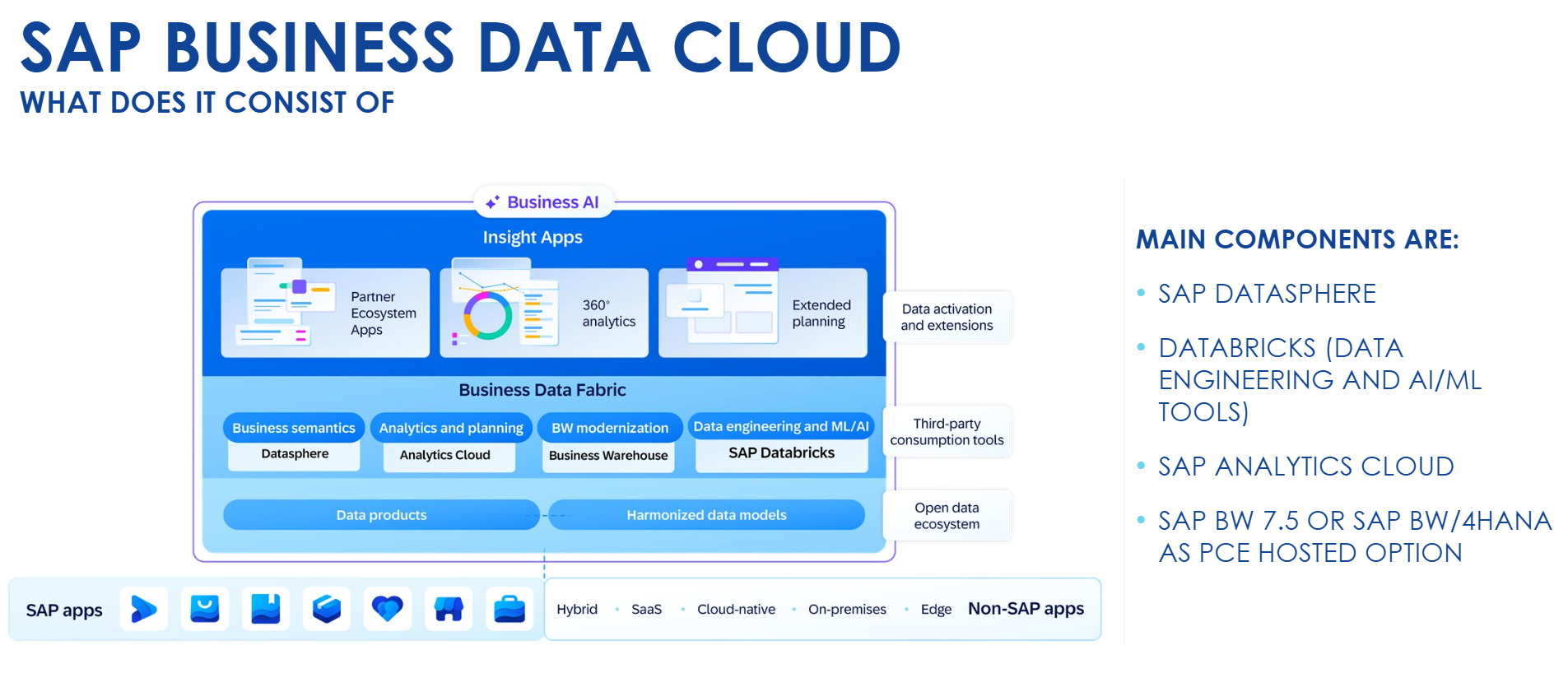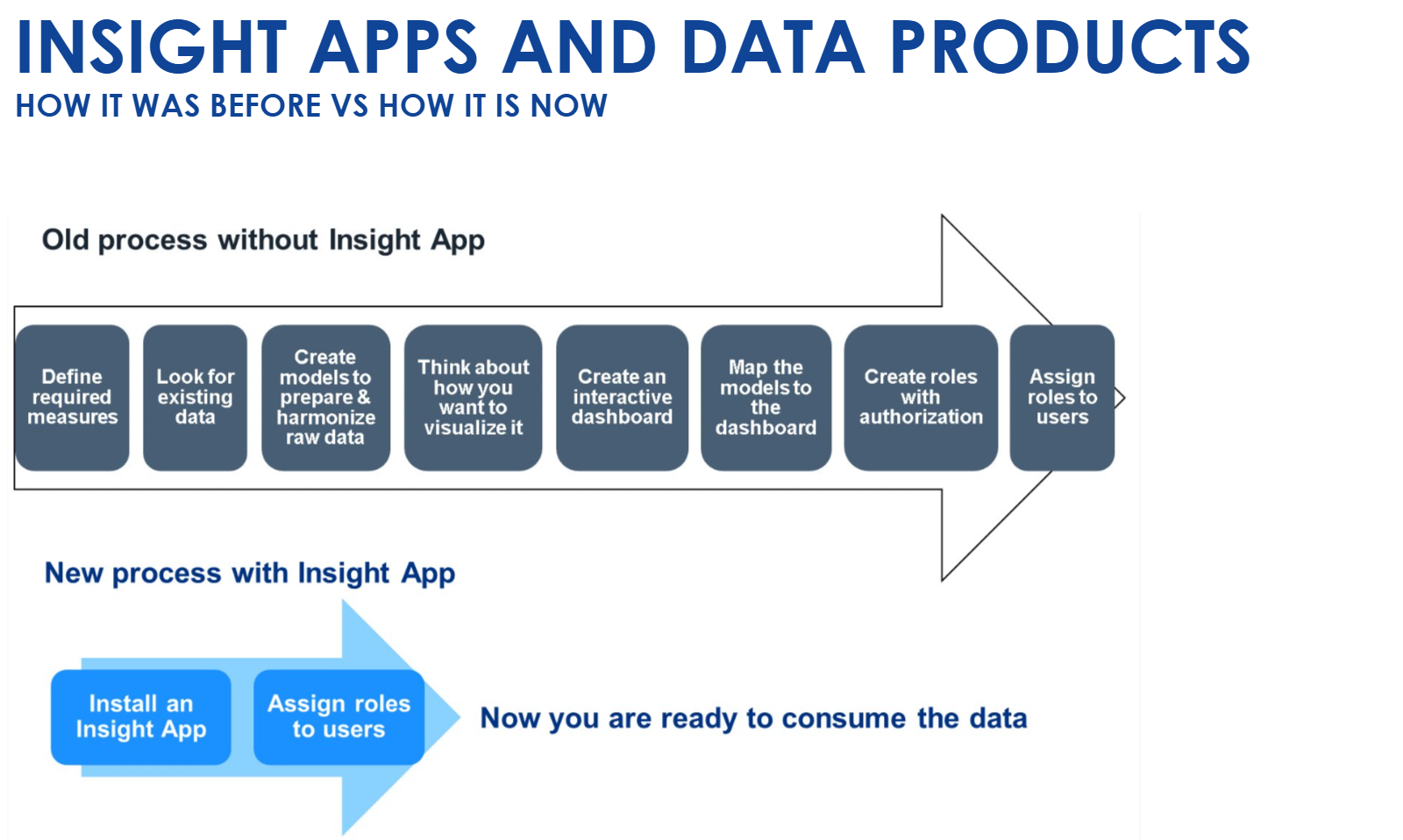What is SAP Business Data Cloud?
SAP Business Data Cloud is a data platform that helps you access, connect, and use data across your entire organization – without copying it or losing its meaning.
It's designed specifically for businesses using SAP systems, but it also connects to third-party and non-SAP sources. The main goal? To let you use real-time, trusted data for planning, analytics, and AI – without building complex data pipelines or creating disconnected data silos.
In the past, different systems in your SAP IT landscape had to be connected manually, and each one required a separate content setup. There was no shared, unified content – and sooner or later, that created gaps in the process.
SAP Business Data Cloud changes that.
It enables your data to work across the systems you use. Previously, you could spend months creating a custom report. For example, in SAP Analytics Cloud, activating content (with adjustments) used to take 20–40 days – and fully custom setups could take up to a year. With SAP BDC, you don't have to do that anymore! It simply delivers unified content and best-practice templates out of the box, so you can get value much faster and avoid all the manual work.
Here's what it does:
-
Brings your data together – without moving it.
SAP Business Data Cloud works with live connections. That means your data remains where it is (in SAP S/4HANA, BW, third-party databases, etc.) but becomes instantly usable for reporting, planning, or AI purposes without duplication.
-
Keeps the business context.
You don't just get raw tables – you get business-ready data. For example, when financial data comes from SAP S/4HANA, it arrives with its structure, hierarchy, and logic intact, making it ready for analysis without manual cleanup.
-
Supports trusted, governed use of data.
Everyone sees consistent numbers, no matter where they look. Finance, supply chain, and sales teams work with the same definitions, hierarchies, and data rules.
-
Speeds up analytics and planning.
With direct access to real-time data, you can build reports or simulate scenarios much faster – no waiting for overnight batch jobs or manual exports.
-
Works across tools.
SAP Business Data Cloud integrates natively with SAP Analytics Cloud, Datasphere, and non-SAP tools like Power BI or Tableau, allowing you to analyze your data in the way that suits you best.
In short, it helps you use the data you already have – better, faster, and with full trust in what it means.
How SAP Business Data Cloud makes your work with data as easy as never before
| Customer challenges | What SAP BDC does | Customer benefits | |
|---|---|---|---|
| Semantics and control | When SAP data is moved to external systems, it loses its business meaning (semantics), and companies waste time and money trying to rebuild it. | Delivers prebuilt, unified business semantics out of the box. | Maintaining the original SAP business context, saving time and effort. |
| Data lake provisioning | There’s no affordable way to manage SAP and non-SAP data together, so businesses often send SAP data to third-party data lakes. | Offers built-in bi-directional integration with Databricks and uses Datasphere's own embedded data lake with storage included. | Effective management of all data (SAP and non-SAP) in one place, with support for AI and machine learning. |
| Data access and integration | With the increasing need to utilize more data for reports and planning, the integration of data from diverse sources and those with inconsistent semantic models becomes increasingly challenging, time-consuming, and complex. | Provides a shared environment where SAP and non-SAP data are harmonized and ready to use on a single data model. | Use all your data – SAP or not – together, right away, and with less effort. |
| Building data-driven applications (AI, Insights) | Businesses must invest heavily шт building analytics and AI tools on SAP data to unlock its full potential. | Includes built-in access to analytics, insights, and recommendations – no need to build everything from scratch. | Quick access to valuable insights and recommendations within SAP apps, based on your data and industry benchmarks. |
What’s inside SAP Business Data Cloud?
https://acbaltica.com/upload/medialibrary/a6d/cejwctubxahedzvx01el5uvdbtz432cc/unnamed.pngSAP Business Data Cloud is a solution that brings together the applications you use, data from various sources (SAP and non-SAP, cloud and on-premise), and SAP Business AI – all under one umbrella, seamlessly integrated.
Let's briefly explore the content of SAP Business Data Cloud.
SAP Analytics Cloud
SAP Analytics Cloud (SAC) creates the analytics layer in SAP Business Data Cloud that brings together planning, business intelligence, and predictive analytics in one place.
Key capabilities of SAP Analytics Cloud in Business Data Cloud:
- Real-time dashboards and visual reports – track KPIs, sales, finance, or operations performance with interactive charts and self-service tools.
- Integrated planning – align financial and operational planning across departments directly within the same platform where your data lives.
- Predictive analytics and forecasting – use built-in AI to detect trends, forecast outcomes, and simulate what-if scenarios.
- Natural language queries – ask questions like "What were our sales in Q2 in Germany?" and get instant, data-driven answers.
- Seamless integration – works natively with SAP S/4HANA, SAP Datasphere, and other SAP solutions, meaning you always analyze the latest data without manual syncing.
Basically, SAC turns raw data in SAP Business Cloud into actionable insights – all within the same ecosystem.
SAP Datasphere
SAP Datasphere is the data layer of SAP Business Data Cloud, designed to provide businesses with unified, secure, and real-time access to their data – regardless of where it resides.
Key capabilities of SAP Datasphere in Business Data Cloud
- Connects all your data sources – from SAP systems (like S/4HANA or SAP BW) to third-party tools (like Salesforce, Google BigQuery, or Snowflake), without needing to move all the data.
- Keeps data context and logic intact, meaning that rules and relationships from the source systems are preserved and ensuring your reports and models remain accurate.
- Real-time data access – instead of duplicating data for analytics or planning, Datasphere lets tools like SAP Analytics Cloud use live data directly.
- Centralized governance and security – manage data access, privacy, and compliance across your landscape with built-in controls.
- Open and extensible – integrate with non-SAP tools and platforms using open connectors and APIs.
In short, SAP Datasphere makes sure the right people have access to the correct data, with full trust and clarity – forming the foundation for analytics, planning, and AI in SAP Business Cloud.
SAP Databricks
Collaboration between SAP and Databricks, SAP Databricks is a deep integration between the two systems, which empowers businesses to build their own AI/ML algorithms based on data from their SAP platform. Basically, it takes data with a trusted business context and brings it into the modern data lakehouse and AI platform.
Key capabilities of SAP + Databricks integration:
- Unified data landscape: You can combine SAP data (e.g., from S/4HANA, SAP SuccessFactors) with non-SAP data (e.g., IoT, social, third-party) in Databricks Lakehouse without manually moving or duplicating data.
- Shared semantic model: SAP's business context (metadata, definitions, and hierarchies) is retained and shared with Databricks, allowing data scientists and engineers to understand and trust the data without needing to reverse-engineer it.
- Advanced analytics and AI/ML: Databricks users can run large-scale analytics, build machine learning models, or utilize generative AI on live or replicated SAP data – with proper governance in place.
- Flexible deployment: Works across clouds (Azure, AWS, GCP) with open data formats like Delta Lake, enabling enterprise-wide data strategies.
- Real-time sync: Changes in SAP systems can be streamed or replicated to Databricks in near real-time, supporting up-to-date analytics and informed decision-making.
SAP Business Warehouse Private Cloud Edition
SAP BW PCE (Business Warehouse, Private Cloud Edition), in the context of SAP Business Data Cloud, plays a role in centralizing and modeling historical business data – especially if your company is already running SAP applications. It serves as a legacy-compatible bridge (to support usage of data from legacy on-premise sources), enabling gradual modernization and reuse of existing assets while connecting to cloud-native tools like SAP Datasphere and SAP Analytics Cloud.
Key capabilities of SAP BW PCE in SAP Business Data Cloud:
- Data warehousing foundation: SAP BW PCE provides structured, centralized storage and reporting for business data from multiple SAP (and non-SAP) systems.
- Prebuilt content and models: This includes industry-specific and functional data models, helping organizations jump-start reporting and analytics projects without having to build them from scratch.
- Integration with SAP Datasphere: SAP BW PCE can be connected to SAP Datasphere, allowing organizations to reuse existing BW models and logic while gradually transitioning to a more open, cloud-based architecture.
- Data modeling & transformation: BW PCE supports data cleansing, harmonization, and enrichment through its built-in transformation tools and InfoProviders.
- Reporting with SAP Analytics Cloud: BW PCE data can be visualized and analyzed in SAP Analytics Cloud (SAC) as part of the broader Business Data Cloud experience.
Insight apps
Another layer of SAP Business Data Cloud is Insight Apps, which provide ready-to-use, interactive dashboards and reports built on top of your business data. It's a set of reports (based on SAP Analytics Cloud) tailored to specific roles and tasks that help you understand what's happening in your company by providing clear, visual answers to common business questions.
Key capabilities of Insight Apps in SAP Business Data Cloud:
- Prebuilt, role-based dashboards: Insight Apps provide immediate visibility into key metrics for specific roles or business areas (e.g., finance, procurement, sales), enabling decision-makers to see what matters most.
- Insightful visualization: These reports are built on SAC, meaning they include interactive dashboards, charts, and real-time KPIs and can be customized or extended as needed.
- Live data: Insight Apps pull data from SAP systems (like S/4HANA) and SAP Datasphere, ensuring insights are based on up-to-date, trusted business data.
- No-code/low-code customization: Business users can easily adapt visualizations and filters to fit their needs – without having to write complex queries or rely on IT.
- Use-case scenarios: These apps are tailored to address specific business questions, such as "What's causing margin erosion?" or "Where are we overspending?" – helping companies act more quickly and effectively.
On top of all that, you have an AI layer that provides you with all the AI and ML capabilities (based on your own historical data) – for data-driven decisions, reliable predictions, and a proactive approach to your daily routines and strategic planning.
Why it matters for your business
If you have your data stored in different systems (such as ERP, HR, sales, supply chain, and more), integrating all that data can often be a painful, manual process. SAP Business Data Cloud fixes that by giving you one consistent, trusted view of your data without moving it around.
Benefits of SAP Business Cloud
-
Faster decisions with real-time data
You don't have to wait for daily exports or email spreadsheets. Whether you're forecasting sales or managing cash flow, you always have up-to-date numbers – directly from the source.
-
Everyone speaks the same "data language"
No more debates about "whose number is right." The whole company works with the same definitions, calculations, and hierarchies. That means fewer errors, clearer reporting, and better collaboration across teams.
-
Less manual work
Finance doesn't have to chase down data from IT. Sales don't have to manually export and clean reports. With built-in integrations, users get the data they need in the tools they already use – fast and clean.
-
Ready for AI and planning
If you want to use AI or predictive planning, it all starts with high-quality, well-structured data. Business Data Cloud gives you that foundation – so you can use tools like SAP Joule, Smart Predict, or external AI models with confidence.
-
Future-proof your data landscape
As your business grows or adds new systems, Business Data Cloud scales with you. It connects to other SAP products and external tools, keeping everything integrated and consistent.
Bottom line? It helps your team stop fixing data problems and start using data to solve business problems.
Why choose ACBaltica for SAP Business Data Cloud implementation
Implementing SAP Business Data Cloud isn't just about connecting data – it's about understanding where that data comes from, how it's structured, and how it needs to flow between systems. That's where ACBaltica makes the difference.
-
Deep SAP ecosystem expertise. We've been working with SAP S/4HANA, SuccessFactors, and SAP Sales Cloud (C4C) for years. That means we don't just know the data – we know the systems behind it. Whether your source systems need integration, customization, or cleanup before connecting to Business Data Cloud, we've got it covered.
-
Migration experience that matters. We know that clean data is essential. With dozens of data migration projects under our belt, we have a deep understanding of the inner structure of SAP data, how to map it effectively, and how to transform it for analytics, AI, and compliance purposes. We've seen all kinds of data challenges – and solved them.
-
Hands-on with every component. We've worked directly with all the key components of Business Data Cloud: SAP Datasphere, SAP Analytics Cloud, BW Bridge, SAP BTP, and more. We understand how they work together – and what to watch out for when dealing with real-world systems.
-
We don't stop at the data layer. What sets us apart is our hands-on experience with the source systems themselves. Unlike many partners who focus only on the analytics side, we can configure, extend, and integrate systems like S/4HANA, SF, and C4C to ensure your Business Data Cloud project actually delivers usable, trusted insights. This is where many providers stop – but we go all the way.
-
Competitive prices. We have a delivery center in Eastern Europe, and thanks to that, we can guarantee that our price-to-quality ratio will meet both your needs and budget.
Want a data-driven future where your systems talk to each other and your insights are actually reliable?
Let's build it together!
Frequently asked questions about SAP Business Data Cloud
SAP Business Data Cloud is an integrated data platform from SAP that brings together data from across your systems – SAP and non-SAP – and makes it usable for analytics, planning, and AI-driven insights. It's built on SAP Datasphere and works with tools like SAP Analytics Cloud, Databricks, and SAP AI services.
SAP BDC includes:
- SAP Datasphere for data modeling and integration
- SAP Analytics Cloud for reporting and dashboards
- Databricks for data engineering and AI/ML workloads
- SAP BW or BW/4HANA (optional)
- Insight apps with built-in analytics and recommendations inside SAP systems.
SAP Datasphere is one core part of BDC, focused on data modeling and connectivity. BDC combines Datasphere with other tools (like analytics, AI, and apps) into a complete data-to-insight platform.
Yes. SAP BDC is designed to work with both SAP and non-SAP data sources. It provides connectors and integration options to pull in data from external tools, databases, and cloud services – while keeping everything aligned on a shared data model.
Absolutely. BDC supports AI use cases by integrating with Databricks and SAP AI Core, allowing you to train models, run predictions, and feed results directly into SAP applications.
With ready-to-use data models, prebuilt best practices, and embedded analytics, SAP BDC helps teams avoid starting from scratch. It also reduces the need for constant data movement between systems.
No, but it works best when integrated with S/4HANA. BDC can still work with other SAP systems (like ECC, SuccessFactors, or C4C) and even third-party platforms – but the benefits are stronger when it's paired with SAP's modern ERP.
Cases
View all







